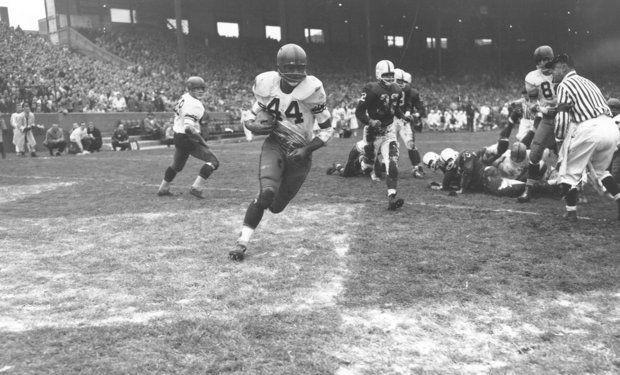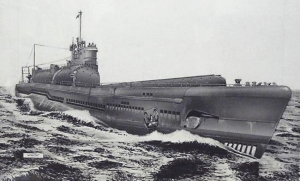Ernie Davis is remembered as one of the most dynamic running backs in NCAA football history. Overcoming adversity is something he had been doing since the time he was born in 1939 in his hometown of New Salem, Pennsylvania. A few days after Ernie was born, his father passed away and his mother was not in the condition to take care of her newborn child. So, Ernie was raised by his maternal grandparents in Uniontown, Pennsylvania. Growing up, Ernie had a bad stuttering problem leaving it hard for him to communicate with others, but his grandparents helped him cope with it and managed to instill strong faith and discipline in him. When Ernie turned twelve, his mother returned back to his life and had him move to Elmira, New York. As Ernie grew older, people all around town began raging about Ernie “the Elmira Express” Davis and his dynamic football skills. He was actively recruited by dozens of colleges. But swayed by his hero Jim Brown, he was convinced to attend the University of Syracuse.1

When Ernie Davis arrived at Syracuse in 1958, his welcome was anything but warm. His own teammates would beat him and target him in practice. There was an incident where a defensive player threw Ernie to the floor and beat him until the coaches pulled him off of Ernie. But, Coach Floyd Benjamin “Ben” Schwartzwalder pushed very hard to get the team to play as one and respect each other as a team rather than hate each other because of the color of their skin. Once Ernie became adapted to the school, and once his teammates warmed up to him, he was moved up to varsity. This was when Coach Schwartzwalder began to shape the young Ernie Davis into the Elmira Express that he would forever be remembered as. In practice, he quickly adapted to this collegiate level and was named the new starting running back for the season to come.2

After Syracuse finished the 1959 season with a respectable record of 8-2 and finishing tenth in the nation, many were hopeful for what the future held for the Fighting Orangemen. So, at the start of the 1960 football season, there were high expectations for both the young Ernie Davis and the Syracuse Fighting Orangemen.3 The Coaches and Boosters of the university questioned whether or not Davis would be able to fill the shoes of future Hall of Famer Jim Brown, and many wondered whether he could lead Syracuse to their first National Championship victory. Ernie Davis and the Fighting Orangemen hit the ground running and went undefeated in the regular season beating nine teams by over a twenty-one point margin.4
The regular season would be nothing compared to what they were going to face in the 1960 Cotton Bowl. The night before the highly anticipated game, Ernie and his team arrived in Dallas, and the hotel they made reservations at refused to let Ernie and two other teammates stay in the main part of the hotel. That night Ernie had to stay in the basement level of the hotel where he woke up to a pile of death threats and letters telling him not to compete in the Cotton Bowl. In fear of a violent outburst at the game, the Mayor of Dallas, Robert Lee Thornton, sent snipers to the stadium in an effort to try to ensure peace during the game.5
The moment of truth had finally come for the Orangemen, and it was time for the Elmira Express to lead his team to a National Championship victory at the Cotton Bowl. From the moment the ball was kicked off it was clear that Davis was playing on another level, as he averaged 7.8 yards per carry. As the game progressed, Ernie started getting beat up after plays, particularly in dog piles, and they gradually got worse. Tensions between the two teams were rising. Ernie Davis was beaten so badly after one play that he had to be escorted to the locker room so a doctor could look at his already injured hamstring. But, Davis would later be returned to the game, after going against what the doctor had suggested, which was to sit out the rest of the game and take it easy. Halftime was approaching and the score was 15-0. Syracuse was up and the aggression and altercations began to get worse. Then: “John Brown, a Negro lineman, played nose to nose against 235-pound Texas tackle Larry Stephens. To goad him off balance, Brown claimed, Stephens kept calling him ‘a big black dirty nigger.’ Finally, Brown warned him not to call him that again. When Stephens did, Brown swung.”6 That punch exploded into an all-out brawl between Texas and Syracuse, which would come to be known as “The Battle of the Hard-Noses.” Syracuse eventually went on to win the Cotton Bowl and claim their first National Championship in school history.7
The 1961 season came, and Ernie Davis just kept getting better. That season, he averaged 7.8 yards per carry and ended up breaking the school record for touchdowns in a single season. Everyone in the country was watching The Elmira Express shatter records and continue to carry his team to victory. The Fighting Orangemen would end up finishing the season 8-3, and finished sixteenth in the country and won the Liberty Bowl.8 Once the Season was concluded, the press and people began to discuss the Heisman Trophy Ceremony. Even President John F. Kennedy sent Ernie Davis a telegram commending him on fighting and competing in a sport he loved, and wished him luck in his NFL career and the upcoming Heisman Trophy Ceremony. Although the president was very supportive of young Ernie Davis, much of the country still made it hard for Davis to go places or be normal. There were many reports that he had still been receiving death threats constantly since the Cotton Bowl. There was even an incident where people were throwing food at him in public while he was on a run in the weeks leading up to the Heisman.9

For many years, African-American players weren’t even considered for the Heisman Trophy. Even the NFL Hall of Famer and Ernie Davis’s hero, Jim Brown, was nominated and clearly deserved the Heisman in 1958. When the day of the Heisman Trophy Ceremony had finally arrived, there was still no clear candidate that stuck out as the next Heisman trophy winner. So who would win was still very unclear to the country. But in 1961, Ernie Davis became the first African American to win the Heisman Trophy, and JFK was there to present the trophy to him personally. This event gave the Civil Rights movement momentum, and helped Americans begin to see that this concept of equality could be achieved.10
After winning the Heisman Trophy, Ernie Davis was prepared for the All-American game and was drafted by the Cleveland Browns as the first overall pick in the 1962 NFL draft. One day, while at practice, Davis passed out and laid unconscious on the field, and was rushed to the hospital. He was placed in the hospital for an extended period of time, and the doctors ran numerous tests on him. After this time, he was eventually released from the Cleveland Browns because they discovered that he had been diagnosed with leukemia.11
On May 18, 1963, Ernie the Elmira Express Davis died. Ernie Davis changed the game of football; he was the first African American to win the Heisman and be the first pick in the NFL draft. Davis never said much, but he led by action, and made change through action. He became an inspiration to a lot of people in American society and refused to ever let the color of his skin hold him back from chasing his dreams. He will forever be remembered for that.12
- Eric Quackenbush, “Ernest ‘Ernie’ Davis: The Elmira Express,” Bleacher Report, June 24, 2009. Accessed February 7, 2018. http://bleacherreport.com/articles/205915-ernest-ernie-davis-the-elmira-express. ↵
- Brad Kelly, “Ernie Davis, Uplifting Champ Rush To The Top: He led Syracuse to the national title before his young death,” Investors Business Daily, December 14, 2009. Accessed January 29, 2018. ↵
- Eric Quackenbush, “Ernest ‘Ernie’ Davis: The Elmira Express,” Bleacher Report, June 24, 2009. Accessed February 7, 2018. http://bleacherreport.com/articles/205915-ernest-ernie-davis-the-elmira-express. ↵
- Eric Quackenbush, “Ernest ‘Ernie’ Davis: The Elmira Express,” Bleacher Report, June 24, 2009. Accessed February 7, 2018. http://bleacherreport.com/articles/205915-ernest-ernie-davis-the-elmira-express. ↵
- Ben Cosgrove, “LIFE at the 1960 Cotton Bowl: ‘Battle of the Hard-Noses’,” Time, January 2, 2014. Accessed January 29, 2018. http://time.com/3878581/cotton-bowl-1960-when-syracuse-whipped-texas-forthe-national-title/. ↵
- Ben Cosgrove, “LIFE at the 1960 Cotton Bowl: ‘Battle of the Hard-Noses’,” Time, January 2, 2014. Accessed January 29, 2018. http://time.com/3878581/cotton-bowl-1960-when-syracuse-whipped-texas-forthe-national-title/. ↵
- Ben Cosgrove, “LIFE at the 1960 Cotton Bowl: ‘Battle of the Hard-Noses’,” Time, January 2, 2014. Accessed January 29, 2018. http://time.com/3878581/cotton-bowl-1960-when-syracuse-whipped-texas-forthe-national-title/. ↵
- Eric Quackenbush, “Ernest ‘Ernie’ Davis: The Elmira Express,” Bleacher Report, June 24, 2009. Accessed February 7, 2018. http://bleacherreport.com/articles/205915-ernest-ernie-davis-the-elmira-express. ↵
- Eric Quackenbush, “Ernest ‘Ernie’ Davis: The Elmira Express,” Bleacher Report, June 24, 2009. Accessed February 7, 2018. http://bleacherreport.com/articles/205915-ernest-ernie-davis-the-elmira-express. ↵
- Sean Krist, “Ernie Davis and JFK: More than 50 years ago, key figures in D.C. football time of change,” Syracuse.com, August 20, 2o14. Accessed February 21, 2017, http://www.syracuse.com/kirst/index.ssf/2014/08/ernie_davis_and_jfk_more_than_50_years_ago_key_figures_in_another_dc_football_ca.html. ↵
- Eric Quackenbush, “Ernest ‘Ernie’ Davis: The Elmira Express,” Bleacher Report, June 24, 2009. Accessed February 7, 2018. http://bleacherreport.com/articles/205915-ernest-ernie-davis-the-elmira-express. ↵
- Salem Press Biographical Encyclopedia, January 2016, s.v. “Ernie Davis,” by Stephen Schwartz. ↵



64 comments
Suvesh Vasal
Wow, this article had so many different levels to it. I am impressed with how detailed it was and how you commended his efforts. He really did change the game of football and the sad thing is I do not think many people know about him. It is impressive that he managed to play so well with all the threats he received the day before the game. I could not imagine going through what he had to and I’m sorry to hear that such a great and powerful man had such a short NFL career.
Jasmine Jaramillo
Before reading this article I had never heard of Ernie Davis. I was impressed with the number of details this article provided. Davis had to overcome many struggles to get where he ended up. From constant bullying and threats to being a child without a mom to even being an outcast on his own team for some time. It was cool to see that President Kennedy supported Davis. I really enjoyed reading this article I feel like it told Davis story well.
Alexandra Cantu
This article was extremely informative since before reading this I don’t know much about college sports or Ernie Davis. Though its sad to say but this archetype has been heard of before about the struggles of young African American’s being able to play. Ernie had to face so much while trying to follow his dreams. I really enjoyed reading this article. Ernie Davis deserves more recognition.
Nathan Hudson
It is great to read about a man strong in morals who overcame the hatred of others. Back then, it was a tough time and he lead his team nonetheless. Through his courage and fantastic skills, Ernie was able to become an amazing running back. It was interesting to read about his home life and what he had to go through. I am inspired by stories like this and you told it very well.
Cristina Cabello
This is a really interesting and inspiring story. I really like to read about these kinds of stories. How people work really hard and are able to achieve their dreams. I also liked how you organized this article. Ernie Davis lived in a hard time period but he made it look so easy to conquer. He is a true historical hero. You did a great job.
Cheyanne Redman
Prior to reading, I had no idea who Ernie Davis was. I find his story to be one that is inspirational, he is the ultimate underdog who turned around and made a success for himself. This article really shines a light into who this man really was and all the adversaries he faced just based on his color of skin. I think its truly wonderful he became the first pick of the NFL draft and the first winner of the Heisman Trophy. This article is well written and well organized. good job.
Regina De La Parra
What an inspiring story! This article explained in a very descriptive way the struggles of Ernie Davis. It is really amazing how this football player suffered so much, even on behalf of his teammates and still was able to have an amazing career in football. I had never heard of this athlete, but this article allowed me to learn about him. Also, this was very informative with good references. Great job Thomas!
Caroline Bush
Great article! Before reading this article I had never heard of Ernie Davis or the impact he left on the game. Its sad that just because of the color or Ernie’s skin he was so badly mistreated. I found it inspiring how despite all the struggles Davis faced he still went on to become the first African American to win the Heisman trophy. Overall this was a very interesting article with a great topic.
Carlos Vazquez
I had never heard of Ernie Davis. I don’t know much about college sports but I have heard about the struggles of young African American’s went through to be able to play in the 50s and 60s. It is sad to hear that Ernie had to face so much adversity while trying to follow his passion. This article was very well written and informative, I really enjoyed reading it.
Jose Figueroa
The article was very will written in how athletes can influence the people of a country. By having such a stellar collegiate career for Syracuse, it was only right he won the Heisman trophy. More importantly, was the impact he had on civil rights during that time period. Sadly, he passed away before he could shine in the NFL and have an impact on an even larger scale.